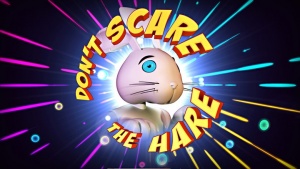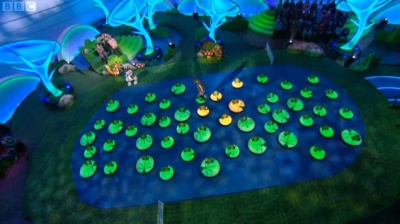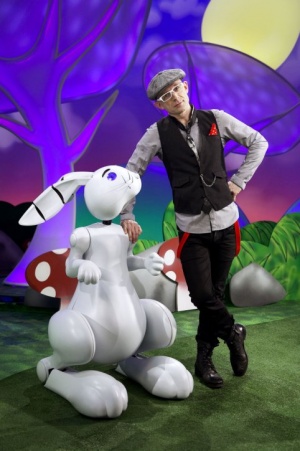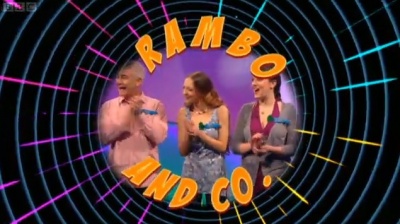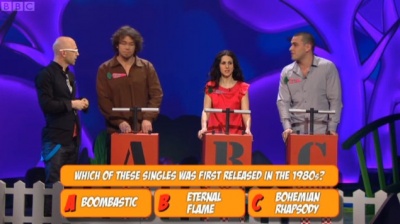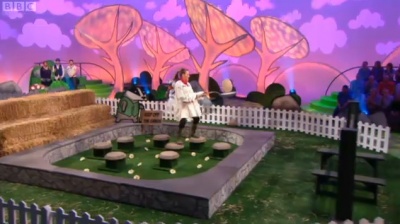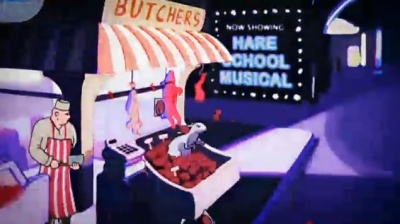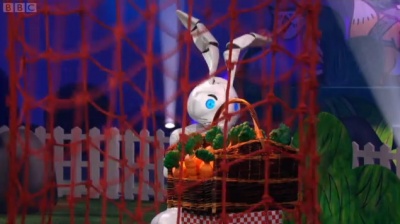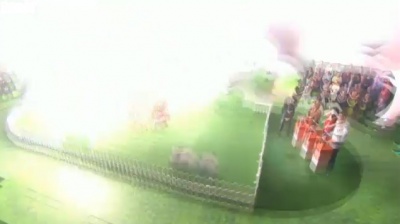Don't Scare the Hare
Contents |
Host
Co-hosts
Barry Davies (Voiceover: non-broadcast pilot)
Sue Perkins (Voice of The Forest)
Featuring: The Hare
Broadcast
Initial Scotland (an Endemol company) for BBC One, 23 April to 18 June 2011 (9 episodes in 1 series)
Synopsis
Two teams take part in puzzles and physical games in which they have to avoid the booby-traps that will "scare" an animatronic hare.
The setting is, apparently, an "underground forest", though it certainly doesn't look like it's underground, what with having a skyline, with clouds, a sun, moon, and photosynthesising flora. All of it fake, of course... but then again, for the "underground" to be a medium-aware reference to it being a TV creation, the studio would have to be underground in real life. Unless the point is that the real, overground studio set represents a fake, underground studio set, and frankly, we're not sure they're really going that meta.
Anyway, in this underground-overground forest live a group of furry animals who make good use of the things that they find, things that the everyday folk leave behind. However, since they declined to take part in this show, the focus is instead on Channel 5's Jason Bradbury, all dressed up like a vagrant golfer, and an animatronic hare known as The Hare, which is certainly a name that gets straight to the nub of the issue and no messing about.
There are also some contestants, two teams of three in fact (adults rather than children, a fact that will become significant later on). And props. Lots of cartoonishly unconvincing props. There's no game without them!
Speaking of games, three are played in the main part of the show, and they're all basically physical challenges, sometimes with a puzzle or memory element. In the first episode these were hopping around in a sleeping bag to stop alarm clocks going off, hooking carrots with fishing rods, and remembering sequences and using them to "cross" a pond of lilypads. Really, nothing you haven't seen on a million other family game shows.
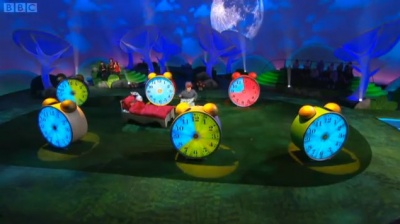 Jump around in a sleeping bag, turning off clocks. Frankly, if the hare's stupid enough to have this many alarm clocks, he deserves to be woken up.
Jump around in a sleeping bag, turning off clocks. Frankly, if the hare's stupid enough to have this many alarm clocks, he deserves to be woken up.In the first two games, the scoring is simply: complete the task without making three errors, and you score three points (represented by oversized plastic carrots), make three mistakes and you score nothing (represented by an absence of oversized plastic carrots). In addition to the standard flashing lights and sirens to indicate a mistake, the hare gets - uh-huh - scared, and runs away in a rather unconvincing manner. Weirdly, there's no actual penalty for scaring the hare once or twice, even though the "three carrots / three scares" symmetry is perfectly suited to a "lose a life, lose a carrot" modification.
The third game is head-to-head and has lots of carrots on offer in a hugely score-unbalancing way. After this, the winning team plays a thinly-disguised but ultimately bog-standard get-three-questions-out-of-five-right endgame for an all-or-nothing prize of fifteen grand, and our hyphen key conks out from overuse.
As children's game shows go, it's alright. If you liked Fee Fi Fo Yum, Relic - Guardians of the Museum, Trapped, Get Your Own Back, et cetera, then you'll probably like this. The games aren't original but they're adequately well designed, you can tell what's going on, and the hare's cute.
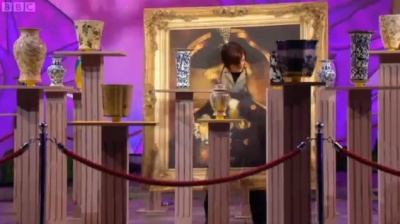 When Antiques Master Goes Bad
When Antiques Master Goes BadOnly trouble is, they've tried to take this halfway-decent children's show and make a family show out of it. How? According to Jason Bradbury, "It's about mum and dad liking the Fiona Bruce gags, the kids loving the bunny and the teenagers loving the guy from the Gadget Show." So, something to annoy everyone. Great!
It would appear that the way you (try to) make a children's show appeal to grown-ups is to pepper the script with acknowledgements of the show's artificial set up, which only really works when it's shamelessly handwaving elements that don't really make sense (like sweepingly claiming "everyone accepts" that frogs croaking is a scary noise).
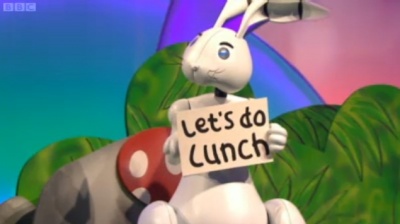 Is this fond farewell from the hare to a departing team an in-joke referring to Sue Perkins' starmaking role? Er, no. When they filmed this, they thought Miranda Hart was going to do the voiceover.
Is this fond farewell from the hare to a departing team an in-joke referring to Sue Perkins' starmaking role? Er, no. When they filmed this, they thought Miranda Hart was going to do the voiceover.The other main technique is to make references that will go over six-year-olds' heads. Describe a contestant as looking like "a young Cher in wellies". Mention Fiona Bruce a lot (more a motif than a running gag per se). Refer to 20th century cultural phenomena, e.g. "Please be careful because we do not want another frog chorus. Oooh, that was a terrible song." (The generous interpretation would be that this is a multi-layered self-deprecating joke drawing parallels between Paul McCartney's "We All Stand Together" and this show, inviting the viewer to consider the difficulty of attempting to produce a work for children that will also appeal to adults. The realistic interpretation would be that it's a lazy sneer.)
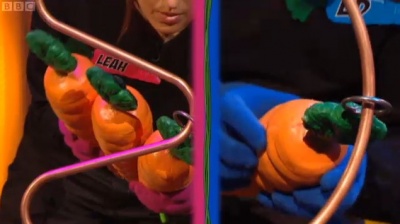 They do this on The Cube too. They really do.
They do this on The Cube too. They really do.Much of the rest, when it's not mere exposition, is simply cloying. Part of the problem is that taking a "we know it's naff, you know it's naff, let's just go with it" tone is all very well when you're discussing something with the scale and spectacle of Total Wipeout, but not such a good idea when it only serves to draw attention to the fact that naffness is all you've got. On the credit side, at least we're spared endless "hare" puns - a particular relief given that the one hidden in the opening credits doesn't even work.
Actually, the wordplay in general seems rather half-hearted. In episode one Perkins said "The frogs are dying to make a noise. They love the sound of their own croak." and we still haven't worked out whether that was meant to be a "dying"/"croak" pun or not. Even as an attempt to appeal to adults, that would be a little dark, wouldn't it? But it's either a jarringly bleak joke, or a jarringly weak joke. And then there was "Barry is on a roll. That, and a floating chair." NOOOOOOOO! THAT'S NOT HOW YOU DO ZEUGMA!
Ahem. Alright, let's get down to basics. Somewhere in all this mess is a derivative but passable children's show. But it's been meddled with, had a "family" spin put on it, and desperately oversold, leading to a huge backlash (online, that is - it seems to have gone almost completely unnoticed by the professional critics). If we might drop out of genre for a moment, a suitable comparison might be Morris Minor's Marvellous Motors, Tony Hawks' 1989 sitcom basically made for kids, but stuck in an early Saturday-evening timeslot in the hope of getting a "family" audience, only to be utterly mauled by the critics and ignored by viewers. (Top character actor Andy Serkis was in it. His official CV doesn't exactly play it up.)
Don't Scare the Hare doesn't really offer anything new, its attempts to appeal to a general audience are somewhat hamfisted, and it probably shouldn't be the lead-in to Doctor Who (a programme that does the "family appeal" thing absolutely right), but it's not the definitively awful show that many would suggest. It's just a resoundingly mediocre one promoted way out of its league.
Catchphrases
"Don't Scare the Hare!"
Inventor
To be completed
Theme music
Marc Sylvan and Richard Jacques
Trivia
This was the first programme to be recorded at the new BBC North studio complex, part of the MediaCityUK development at Salford Quays.

